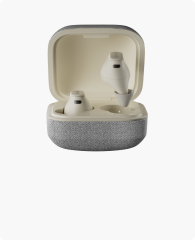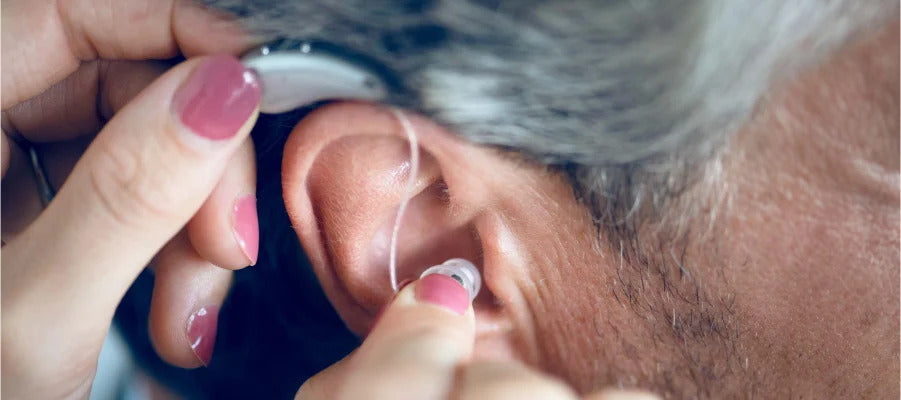While some of the hearing devices can be bulky, RIC hearing aids can be an ideal choice for people who want a discreet design. They are sleek and modern, which sit behind your ear and deliver clear, natural sound straight into your ear canal. RIC hearing aids are popular for a reason; the only problem is whether they are the right fit for you.
If you are wondering the same question, this guide will introduce what RIC hearing aids actually are, how much they cost, who should wear them, how to choose the best RIC hearing aids, and tips for cleaning and protecting them. Just read on!
🚀 Navigate This Post
- ➤ Part 1: What Does RIC Mean in Hearing Aids?
- ➤ Part 2: RIC Hearing Aids Price — Are They Affordable?
- ➤ Part 3: Why Wear RIC Hearing Aids? — Pros & Ideal Users
- ➤ Part 4: Best RIC Hearing Aids — How to Choose the Right One?
- ➤ Part 5: Protecting RIC Hearing Aids from Moisture and Damage
- ➤ Part 6: Cleaning RIC Hearing Aids — Best Practices
- ➤ FAQs
You may also be interested in:
- Comprehensive Guide: Everything You Need to Know about Hearing Aids
- Cearvol Diamond X1 Reviews: What People Are Saying About Cearvol Diamond X1
- Why Do My Hearing Aids Squeal Every Time? Experts Reveal the Truth
Part 1: What Does RIC Mean in Hearing Aids?
What does RIC mean in hearing aids? Short for Receiver In Canal, RIC is a hearing aid style where the speaker/receiver is placed in the ear canal, while the rest is placed behind your ear. This design allows RIC hearing aids to deliver clearer and more natural sound with less distortion or feedback.

So, how do receiver-in-canal hearing aids actually work? Let's break down the main components:
1. The Hearing Aid Body
This main body sits behind the ear, which houses the processor (the “brain”) and microphones. The mics will pick up sounds around you and send them to the processor. It then amplifies and sends them to the receiver. All of these happen in milliseconds.
2. The Receiver (Speaker) and Dome
The receiver is placed in the ear canal, which delivers amplified sound. There is a thin wire to connect it to the main body. Meanwhile, there are domes or custom earmolds at the end to keep it snug and comfortable. Styles could vary, depending on your ear shape and hearing loss level.
3. Battery (Disposable or Rechargeable)
The units that power the RIC hearing aids are commonly sized 13 or 312. While 312 batteries last 5 to 7 days, rechargeable models are more convenient.
4. Retention Wire or Canal Lock (Optional)
Chewing or moving your jaw can cause your receiver wire to move out of the ear canal. A retention wire with a dome tip or custom earmold can provide additional support and prevent movement.
Part 2: RIC Hearing Aids Price — Are They Affordable?
Now you might be wondering: What's the typical RIC hearing aids price? Generally, these models can cost anywhere between $1,000 and $3,200 per ear in the US, depending on technology level, brand, and feature. Over-the-counter (OTC) RIC hearing aids may cost less (often under $1,000 per pair), but usually support limited features.

While RIC hearing aids come with a higher price tag, they provide enhanced features and benefits that could be worthwhile for many individuals. Whether RIC models are affordable or not depends on your specific needs, hearing loss, lifestyle, and budget.
Part 3: Why Wear RIC Hearing Aids? — Pros & Ideal Users
So, why should you wear RIC hearing aids since they are a lot more expensive? RIC models are popular for good reasons. They have a lightweight design, offer excellent sound quality, and can manage various degrees of hearing loss.
With numerous benefits, RIC hearing aids are well-suited for individuals with mild to severe hearing loss. They are also often recommended for first-time users because they are comfortable and less visible. If you are looking for hearing aids for seniors, RICs are often a top choice.

Compared to ITE (In the Ear) hearing aids, the models that require custom-molded fits or more wind protection, RICs offer a more open-fit design. They don't block the entire ear canal, enhancing comfort, especially for extended wear.
Compared to BTE (Behind the Ear) hearing aids, the models for individuals with severe hearing loss or pediatric users, RIC hearing aids are lighter and discreet. They are ideal for adults who require comfort and aesthetics without sacrificing performance.
Part 4: Best RIC Hearing Aids — How to Choose the Right One?
Now you should have a grasp of RIC hearing aids. Want to get one as well? When shopping for the best RIC hearing aids, there are several factors to keep in mind:
1. Degree of Hearing Loss
You are recommended to consult with an audiologist first. Conduct a hearing test (audiogram) to assess the type and severity of your hearing loss (mild, moderate, severe, or profound).
2. Lifestyle Consideration
Your lifestyle choices, such as daily activities and communication needs, are important things to consider. Do you frequently attend social gatherings, work in noisy environments, or enjoy music? These needs might require more features of RIC hearing aids.

3. Technology Features
The best RIC hearing aids often come with a wide range of features, including Bluetooth streaming, app control, directional microphones, noise cancellation, and even AI-assisted sound processing. These features can greatly enhance your listening experience in different environments. However, the more features a device has, the higher the price tends to be. Choose the features that truly match your lifestyle.
4. Comfort and Fit
If you are a first-time user, it's better to look for RICs with soft, well-fitted domes or custom earmolds. These open-fit designs can largely reduce the uncomfortable “plugged” feeling.
5. Support and Warranty
It is always recommended to go with brands that offer solid after-sales service, repairs, and trial periods. Some reputable brands also include follow-up fittings as part of the package.
For users with mild to moderate hearing loss, RICs are not the only option. ITE (In-The-Ear) models are also a practical choice. Unlike RIC hearing aids, which have separate components to deal with, ITE models have an all-in-one design. They fit entirely in the ear, which can be customized to the shape of your ear for a secure fit.
Here, Cearvol Diamond X1 is a great OTC option to consider. Powered by an advanced deep neural network, Cearvol Diamond X1 can effectively suppress background noise and enhance speech quality. With its strong Bluetooth 5.3 connectivity, you can enjoy a stable hearing experience without latency. It's highly compact and discreet, offering everyday comfort with high-end features.

Diamond X1 - Best Hearing Aids with Bluetooth
Newcomer Price
$249.99 $309.99
- ✔ Adaptive sound modes for clear hearing.
- ✔ Bluetooth for calls & streaming.
- ✔ App-controlled, customizable adjustments.
- ✔ Rechargeable & fast charging.
- ✔ Ideal for mild to moderate hearing loss.
Part 5: Protecting RIC Hearing Aids from Moisture and Damage
Like any small electronic device, protecting RIC hearing aids from water, sweat, and physical damage is extremely important. The internal components can be easily corroded due to moisture. It's recommended to store them in a dry case and never wear them while swimming or showering.

If you live in a humid climate or plan to wear them while exercising, consider switching to waterproof hearing aids for peace of mind. Meanwhile, sweat and moisture can reduce grip, making it hard to keep hearing aid domes in ears and increasing the risk of them falling out. Also, always remove your devices carefully to avoid accidental drops or damage.
Part 6: Cleaning RIC Hearing Aids — Best Practices
Regular maintenance is essential for maximizing the lifespan of your RICs. Cleaning RIC hearing aids involves a few practices, and they are:
- Wipe daily with a tissue or non-alcohol-based wipe.
- Brush away debris from the microphone ports using hearing aids cleaning tools.
- Replace the wax guard monthly or if the sound becomes muffled.
- Use a dryer like Zephyr to prevent moisture damage from sweat or humidity.
- Use a dehumidifier for humid climates or those who tend to sweat.
If you need a full tutorial, just check out our guide on how to clean hearing aids to learn more.
Frequently Asked Questions
Still have questions about RIC hearing aids? Here are some of the most common ones:








Leave a comment
All comments are moderated before being published.
This site is protected by hCaptcha and the hCaptcha Privacy Policy and Terms of Service apply.